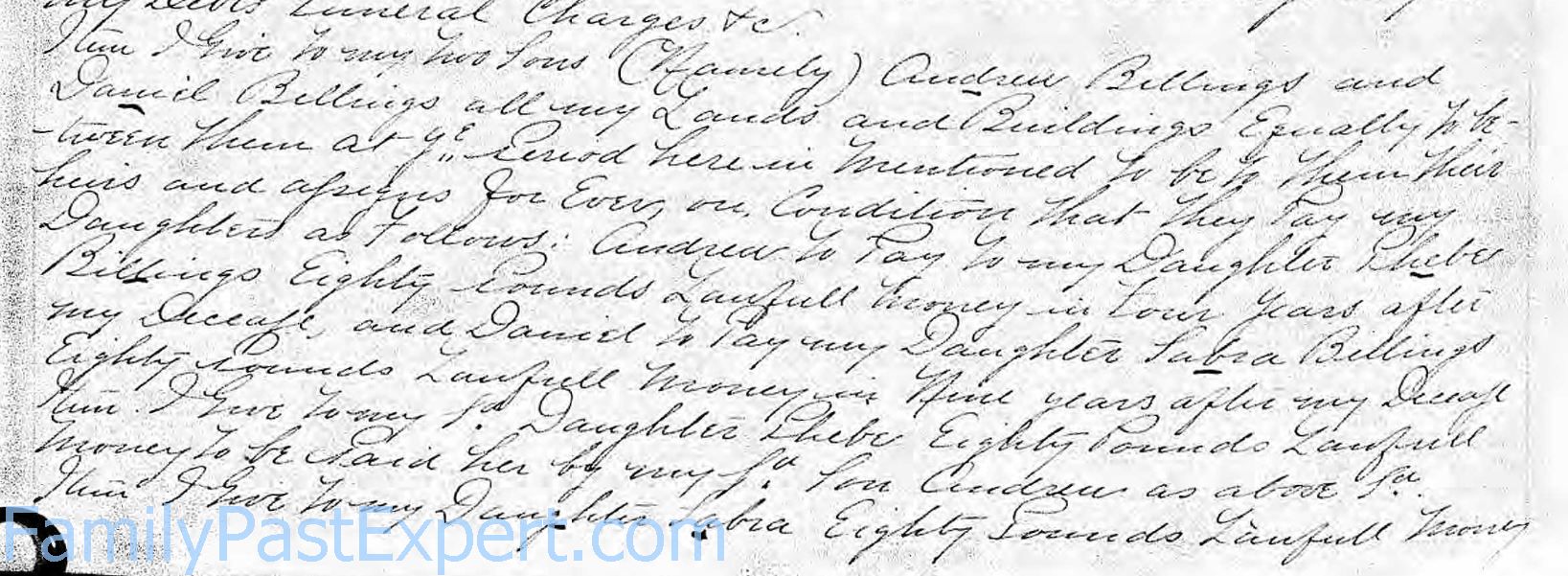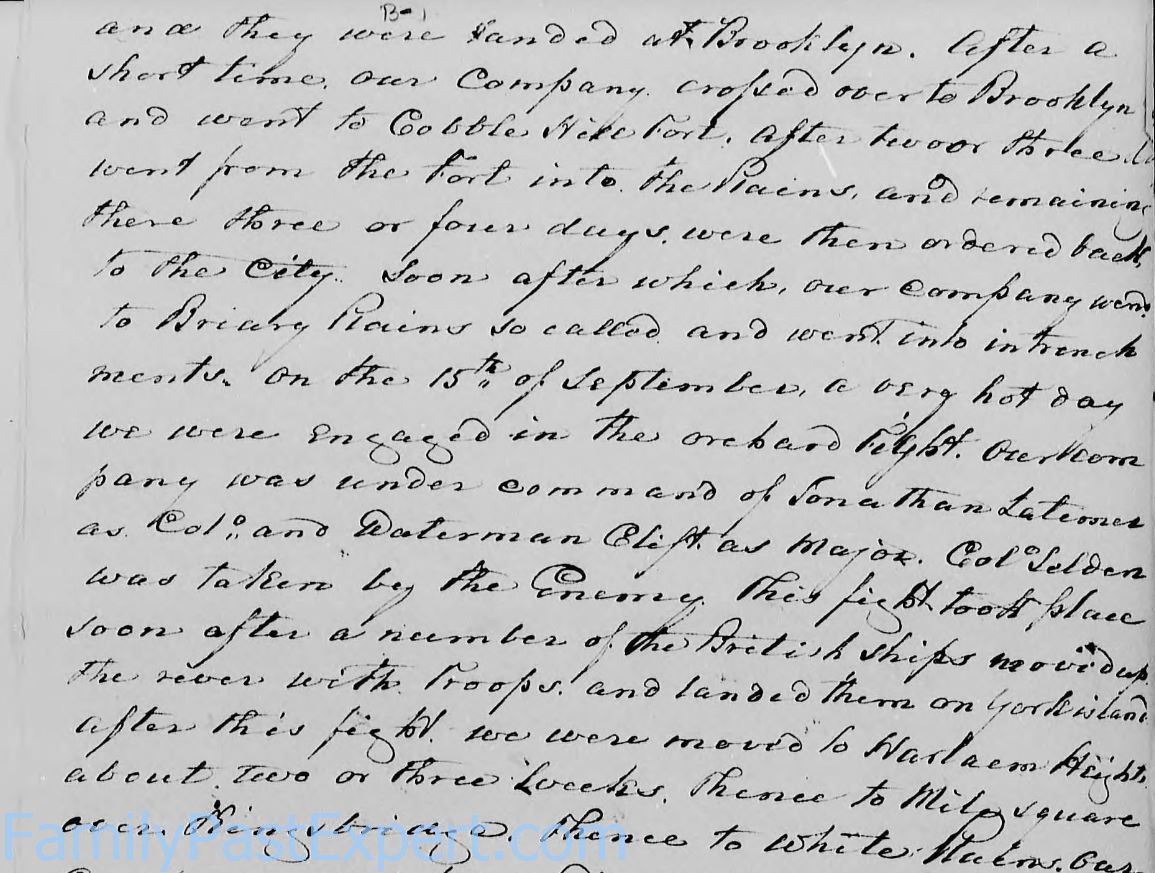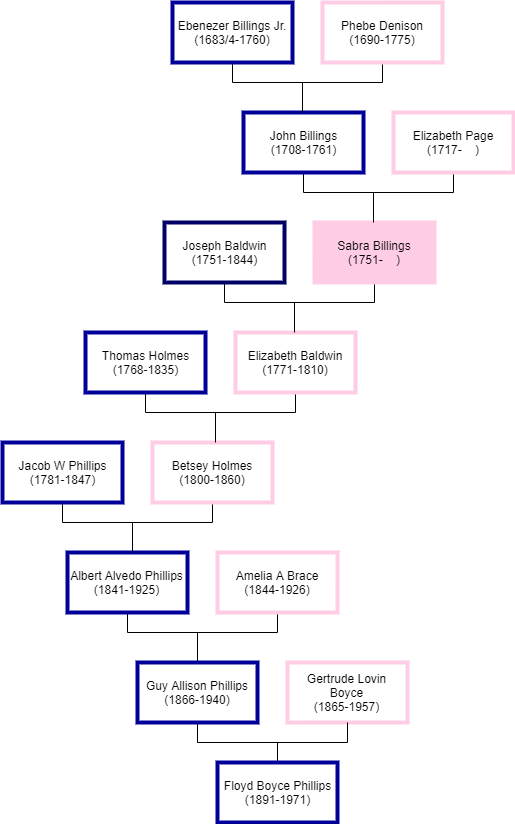Sabra Billings (1751->1840)
Sabra Billings was born 265 years ago and lived in a volatile time in American history.
Birth and Youth
Sabra Billings was born on 16 Jun 1751 in Stonington, New London, Connecticut as the fifth child of John Billings and Elizabeth Page. She had four siblings, namely: Andrew, Phebe, John, and Daniel.
Sabra’s father died on 5 February 1761, when Sabra was not yet ten years old. According to the will, Sabra’s mother was given half of the dwelling house and other buildings and a third of the land owned by the estate to use during her lifetime. For the first five years after his death, she had use of all of it. Though if she remarried, she would only get to use a third of the lands and buildings.
Sabra’s mother also was given all of the movable estate as long as she took care of settling her father-in-law’s estate, and paying the debts of the two estates. Sabra’s grandpa, Ebenezer Billings, had just died the year before, on 20 July 1760, and as executor and oldest son, John Billings was in the midst of setting that estate at the time of his own death. As oldest son, Sabra’s dad had inherited most of his father’s estate for himself and his heirs.
Sabra and her siblings were also provided for in her father’s will. Her brother John had died as a young child, so her brothers Andrew and Daniel were bequeathed all of the land and buildings to be divided equally as long as they pay each of their sisters eighty pounds. Phebe was to get her share four years after John’s decease and Sabra was to get her share nine years after his death. Remember, Sabra was only nine years old when he wrote his will, so she would have to wait until she was eighteen to get her share. The total inventory of the estate was a little better than 1859 pounds, so Sabra’s 80 pounds was about 4% of the total estate.
Marriage and Children
When she was 19, Sabra married Joseph Baldwin, son of Theophilus Baldwin and Sarah Lamb, on 14 Nov 1770 in Stonington, New London, Connecticut.
Joseph Baldwin and Sabra Billings had the following children:
- Elizabeth Baldwin was born on 11 Apr 1771 in Stonington, New London, Connecticut. She married Thomas Holmes on 19 Nov 1789 in Stonington, New London, Connecticut. She died on 04 Mar 1810 in Stonington, New London, Connecticut.
- Sally Baldwin was born in 1774 in Stonington, New London, Connecticut. She married Simeon Clark in Connecticut. She died on 12 Jul 1860 in New London, Connecticut.
- Sabra Baldwin was born in 1777 in Stonington, New London, Connecticut. She married Daniel Thurston in Connecticut.
- Bridget Baldwin was born in 1780 in Stonington, New London, Connecticut. She died before 1860 in New London, Connecticut. She married Robert M Palmer on 03 Feb 1801 in Griswold, New London, Connecticut.
- Joseph Baldwin was born in 1784 in Stonington, New London, Connecticut.
- Andrew B Baldwin was born on 02 Jan 1788 in Lisbon, New London, Connecticut. He married Betsey Hutchins on 01 Jan 1811 in Connecticut. He died on 09 Oct 1882 in Thompson, Windham, Connecticut.
- Henry Baldwin was born on 08 Mar 1790 in Lisbon, New London, Connecticut. He married Abigail Baldwin on 15 Sep 1815 in Connecticut. He died on 19 Aug 1863 in Norwich, New London, Connecticut.
The Revolutionary War
Sabra and Joseph had only been married four years when the Revolutionary War broke out. They were living in Stonington Connecticut, with two young daughters. At the beginning of the Revolution, Stonington had more than 5,000 residents. The town had three protected harbors, so many local shipowners were engaged in West India trade. They exported cattle and other livestock and imported spices, sugar, molasses and rum. In 1773, after years of the Crown provoking the colonists with repeated efforts to raise taxes, the famous Boston Tea Party happened. But in New London, very near Stonington, tea was also destroyed. It was seized and burned. When the War started on 19 April 1775, Stonington sent men to answer the Lexington Alarm. By May 1775, Connecticut had organized 28 militia regiments involving about 23,000 men.
Sabra had to send her husband to war. Joseph Baldwin served as a Sergeant in 1776. He served under Captain Witter and Colonel Latimer. He was engaged at Orchard Fight, New York and also at Kip’s Bay and Harlem Heights, New York.
Battle of Kip’s Bay
The Battle of Kip’s Bay happened on 15 September 1776. About 450 American troops commanded by General George Washington tried to prevent the British commanders Henry Clinton and Richard Howe and their 4,000 men from landing. Washington had been trying to hold New York City, but had gotten into a position where the Americans were vulnerable to the British blocking their escape route from the city. In days prior to the battle, the decision had been made to abandon the city and an evacuation of troops had been in process. But, on the morning of 15 September, British General William Howe attacked the Americans before they could complete their work. Five British warships sailed into the East River and anchored a couple hundred yards offshore from Kip’s Bay. As British ships in the Hudson created a diversion on the other side of Manhatten, 4,000 British and German troops rowed in flatboats towards Kip’s Bay from Long Island. The warships “unleashed a thunderous naval barrage” on Captain William Douglas’ inexperienced troops who were a 450 man regiment from Connecticut. Joseph Baldwin and the other Connecticut soldiers were situated in a shallow trench. The Americans were defeated losing about 50 men to death, another ten to injury and 367 men to capture.
New York, NY
Battle of Harlem Heights
The very next day, George Washington and his troops, including Sabra’s husband Joseph Baldwin, were encamped at Harlem Heights. The British approached the camp, perhaps just to taunt the Americans given their recent defeat. But Washington decided to play offense. He sent 1,000 men directly toward the advancing British line and then sent rangers to work their way south around the right flank of the British. The plan didn’t work exactly right because the rangers had not gotten into the right position, but it caused the British to understand the plan and retreat. There were high casualties in the battle which in total had pitted 1,800 Americans against 5,000 British, but it was an American Victory, the first battlefield victory for Washington.
Danger at Home
Sabra Billings Baldwin and the other inhabitants of Stonington, were not immune to the war either. On 30 August 1775, the British sailed into the harbor at Stonington without flying their colors. They planned to confiscate a shipload of cattle. When the militia commander hailed the British boats, they were answered by cannon fire. American troops assembled and marched to the wharf. Meanwhile, the British tried to steal two ships from the harbor. The British were sent away by musket fire but didn’t go far. They continued to fire cannon balls all morning. During the battle, many women and children were forced to leave their homes and march inland through mud and driving rain. Thankfully, the British left that evening.
Discharge and Draft
Joseph Baldwin was discharged on Christmas 1776 and returned home. Sabra and Joseph’s third child was born in 1777. Then Joseph was drafted and served again as a Private in 1779. During that tour of duty he served for two months under Captain Hewitt at Stonington, Connecticut and was at Fort Griswold and part time at Stonington Fort, Stonington Point, where he was discharged.
Death
Both Sabra and Joseph Baldwin died at Lisbon, New London, Connecticut, but the date of her death has not been recorded. Joseph filed for a Revolutionary War Pension and in that file it states that he died 14 November 1844. He was 93 years old. Some records say that she lived past 1840 putting her well into her 80s, but there is no record of exactly how long Sabra lived.
Where is she in the tree?
Sources:
Ancestry.com, Connecticut Town Birth Records, pre-1870 (Barbour Collection) (Provo, UT, USA, Ancestry.com Operations Inc, 2006).
Ancestry.com, Connecticut Town Marriage Records, pre-1870 (Barbour Collection) (Provo, UT, USA, Ancestry.com Operations Inc, 2006).
Baldwin, Charles Candee, Baldwin: The Baldwin genealogy from 1500 to 1881 [database on-line] (Cleveland: unknown, 1881).
Baldwin, John Denison, A record of the descendants of John Baldwin of Stonington, Conn. (Worcester: Tyler & Seagrave, 1880). Available at https://archive.org/details/recordofdescenda00inbald.
Boas, Norman F., “Stonington in Rebellion, 1775,” The Stonington Historical Society, 1999, Web, 11 June 2016, http://www.stoningtonhistory.org/index.php?id=55.
DAR, ancestor #A20483, http://services.dar.org/public/dar_research/search_adb/?action=full&p_id=A204383.
Gabriel, Michael P., Ph.D., “Battle of Kip’s Bay,” George Washington’s Mount Vernon, Web, 11 June 2016, http://www.mountvernon.org/digital-encyclopedia/article/battle-of-kips-bay/.
Revolutionary War Pensions at Fold3, www.fold3.com, Joseph Baldwin; https://www.fold3.com/image/11007359.
Stockwell, Mary, “Battle of Harlem Heights,” George Washington’s Mount Vernon, Web. 11 June 2016, http://www.mountvernon.org/digital-encyclopedia/article/battle-of-harlem-heights/.






Leave a Reply